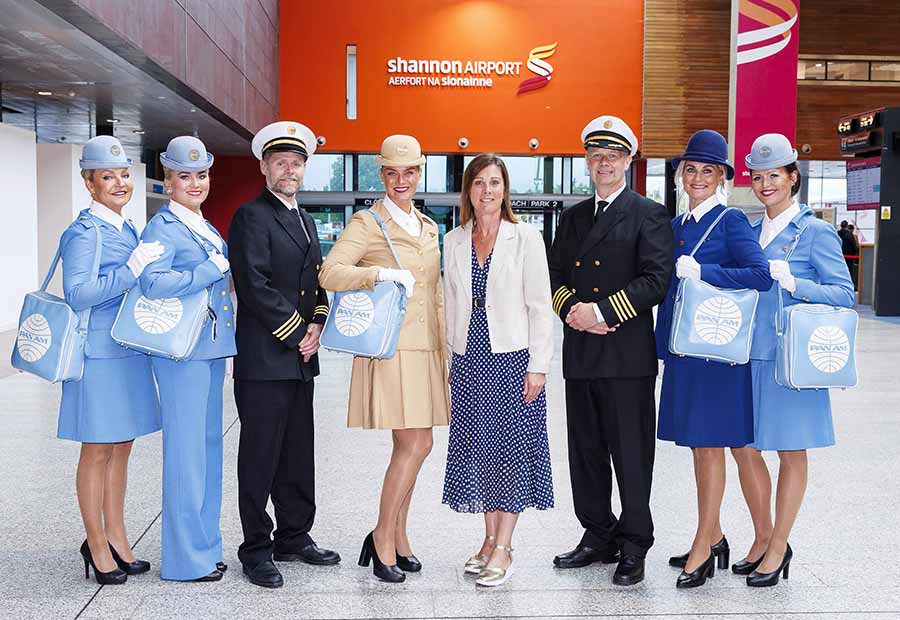
Pan American Airways (or a version of) has departed Ireland again with a Boeing 757-200 that represents 34 years since their last visit. The journey retraces historic transatlantic routes established in the 1930s and 1940s, showcasing airports like Shannon and cities such as New York and London.
Craig Carter, CEO of Pan American World Airways, is hosting the exclusive experience titled Tracing the Transatlantic. This commemorative flight, named “Tracing the Transatlantic,” is hosted by Craig Carter, CEO of Pan American World Airways, and operated by Bartelings in partnership with Criterion Travel.
Fifty passengers each paid approximately $60,000 for this exclusive experience, with their stay in Ireland planned at Adare Manor Hotel. A key highlight of the trip will be a visit to the Foynes Flying Boat and Maritime Museum, where Minister for Culture Patrick O’Donovan and Eamonn Brennan, Chairman of the Museum board, will extend a warm welcome.

The museum reopened last year following a €5m renovation, featuring the world’s sole full-size replica of a Boeing 314 Flying Boat, popularly known as the Yankee Clipper.
The refurbishment includes a cinema, flight simulators, and an exhibition celebrating the life and achievements of actress Maureen O’Hara and her ties to Foynes.
Minister for Culture, Communications and Sport, Patrick O’Donovan TD, officially welcomed the group alongside the museum’s chairman Eamonn Brennan. Craig Carter shared, “This trip is a way to relive the glory days of transatlantic aviation.” The minister, Patrick O’Donovan TD, shared, “It’s wonderful to see Pan Am returning to our shores.
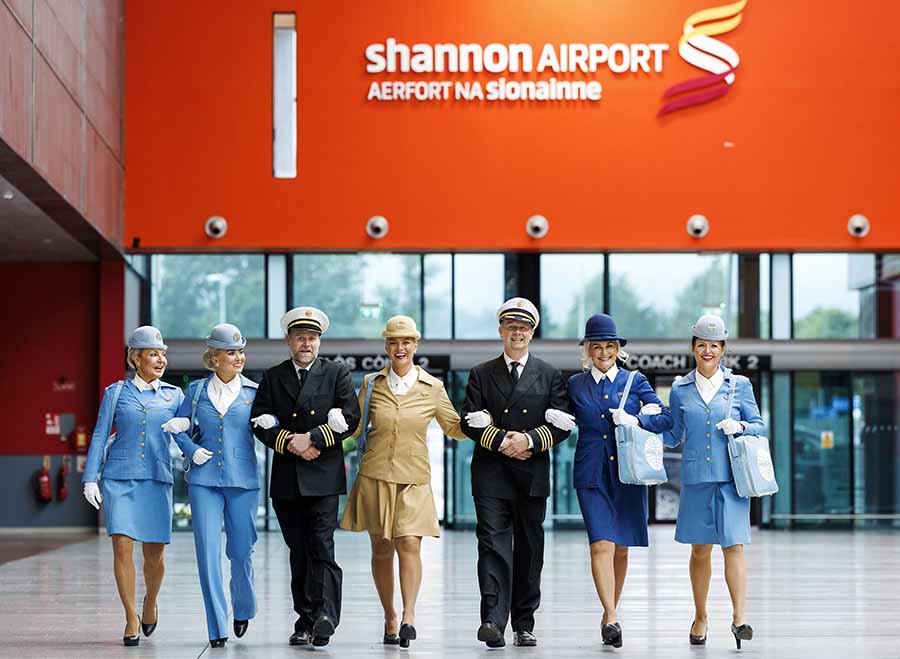
A history of firsts
Pan American World Airways, commonly known as Pan Am, was a trailblazing American airline that shaped the aviation industry from its inception in 1927 until its demise in 1991. Founded by Juan Terry Trippe, a former World War I naval aviator, Pan Am began as a modest operation with a contract to fly mail between Key West, Florida, and Havana, Cuba. Its first passenger service between these cities commenced in 1928, marking the start of a storied journey. Charles Lindbergh, the famed aviator, joined as a technical advisor, helping chart transatlantic routes that would define the airline’s global ambitions.
In its early years, Pan Am expanded rapidly, acquiring smaller airlines in Central and South America to extend its reach across the Americas. By the 1930s, it operated a network of routes using flying boats like the Sikorsky S-40 and Boeing 314 Clippers, which became iconic for their elegance and ability to traverse vast distances. In 1935, the China Clipper completed the first transpacific flight from San Francisco to Manila, and in 1939, the Yankee Clipper inaugurated scheduled transatlantic passenger and mail services, a monumental achievement. Pan Am also completed the first successful round-the-world flight in 1942, cementing its status as a pioneer.
During World War II, Pan Am played a critical role, supporting the U.S. government with logistical operations, including military transport and the establishment of vital air routes. Post-war, the airline transitioned to land-based aircraft like the Douglas DC-4, Lockheed Constellation, and Boeing 377 Stratocruiser, expanding its global footprint to 62 countries by 1947. The 1950s saw Pan Am embrace the Jet Age, introducing the Boeing 707 in 1958, the first American jetliner to fly transatlantic routes. In 1970, Pan Am became the launch customer for the Boeing 747, the world’s first wide-body jumbo jet, revolutionising long-haul travel by making it more accessible and affordable.
Pan Am’s innovations were numerous: it developed the first global computer reservation system (PANAMAC), introduced coach-class service internationally, and pioneered long-range weather forecasting and automatic landings. Its iconic blue globe logo, nicknamed “The Blue Meatball,” and the term “Clipper” for its aircraft became symbols of luxury and glamour. The airline’s cultural impact was profound, featured in films like 2001: A Space Odyssey and associated with high-profile moments, such as The Beatles’ arrival in New York in 1964 on a Pan Am 707.
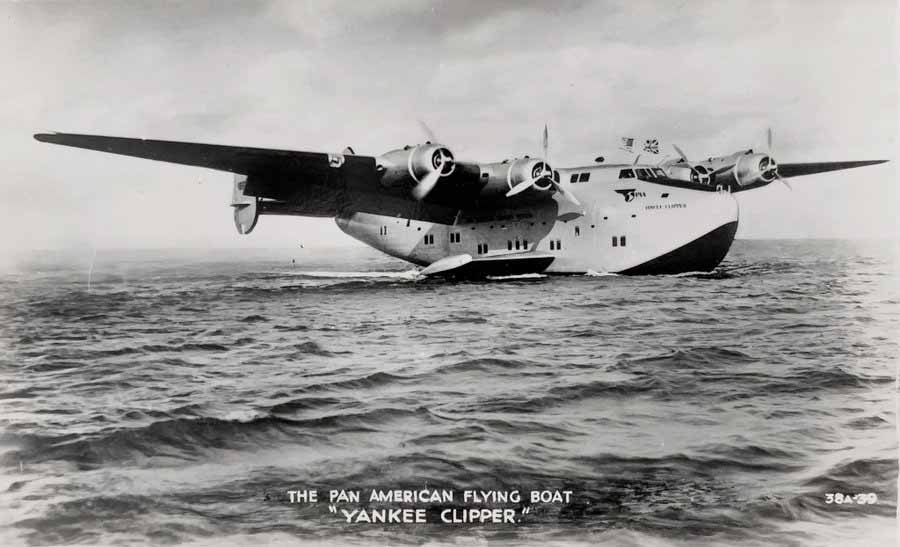
Flying boats to Foynes
The nostalgic landing of a Pan Am-branded Boeing 757-200, “Yankee Clipper II,” at Shannon on 25 June 2025, reinvoked the historic transatlantic networks of a previous age when aircraft did not have the range or capacity that they have today. Between 1937 and 1945, Pan Am conducted 2,097 flights to Foynes across the North Atlantic using the Boeing B314 Flying Boats. The airline transported numerous VIPs, including Ernest Hemingway, Humphrey Bogart, Yehudi Menuhin, John F. Kennedy, Eleanor Roosevelt, and King George of Greece. Upon their arrival in Foynes, singer Gracie Fields spontaneously entertained local residents with a sing-along on the pier.
Pan Am’s Irish journey commenced in 1937 with its iconic flying boats, specifically the Sikorsky S-42 Clipper III, which touched down at Foynes, County Limerick, on 6 July after a survey flight across the North Atlantic from Port Washington, New York, via Newfoundland. Foynes, a quaint seaplane base on the River Shannon, became a vital hub for Pan Am’s transatlantic operations, hosting over 2,097 flights between 1937 and 1945. These flights, operated by Boeing 314 flying boats, carried luminaries such as John F. Kennedy, Ernest Hemingway, and Eleanor Roosevelt, cementing Foynes’ place in aviation lore. The Foynes Flying Boat Museum, home to the world’s only full-size Boeing 314 replica, remains a testament to this golden era. In October 1945, the last Pan Am Flying Boat flight left Foynes as operations transitioned to Shannon Airport, marking the advent of land-based aircraft.
As World War II reshaped global aviation, Pan Am’s operations shifted from Foynes to the newly established Shannon Airport in 1945, marking the transition from seaplanes to land-based aircraft. On 16 September 1945, a Pan Am DC-4 landed at Shannon from Gander, Newfoundland, in the first transatlantic proving flight, heralding a new age of commercial air travel. By October 1945, Shannon welcomed its first scheduled transatlantic commercial flight, operated by American Overseas Airlines (later acquired by Pan Am in 1950), on a New York–Gander–Shannon–London route. Shannon’s strategic location made it an essential refuelling stop, with 6,000 landings recorded in 1947 alone, bringing over 170,000 passengers.
The post-war years saw Pan Am’s operations at Shannon flourish. By the 1950s, the airline’s Lockheed Constellations and Douglas DC-6s were regular sights, with Shannon serving as a key stop on round-the-world routes. For instance, Pan Am’s Flight 1, a global service, frequently included Shannon as a stopover en route from London to New York, with a tragic note in 1948 when Flight 1-10, a Constellation named “Clipper Empress of the Skies,” crashed short of Shannon’s Runway 23, claiming 30 lives. Despite such setbacks, Shannon’s role grew, bolstered by its pioneering duty-free shop, established in 1947, and its reputation for excellent dining.
The jet age transformed Pan Am’s presence in Ireland. In 1959, the introduction of Boeing 707s and later the Boeing 747 in 1971, which first landed commercially at Shannon in April of that year, elevated the airport’s status as a transatlantic gateway. Pan Am’s routes connected Shannon to major cities like New York, London, and Frankfurt, with the airline’s blue globe logo symbolising luxury and adventure. At its peak in the late 1960s and early 1970s, Pan Am carried millions annually, with Shannon benefiting from its extensive network covering 86 countries.
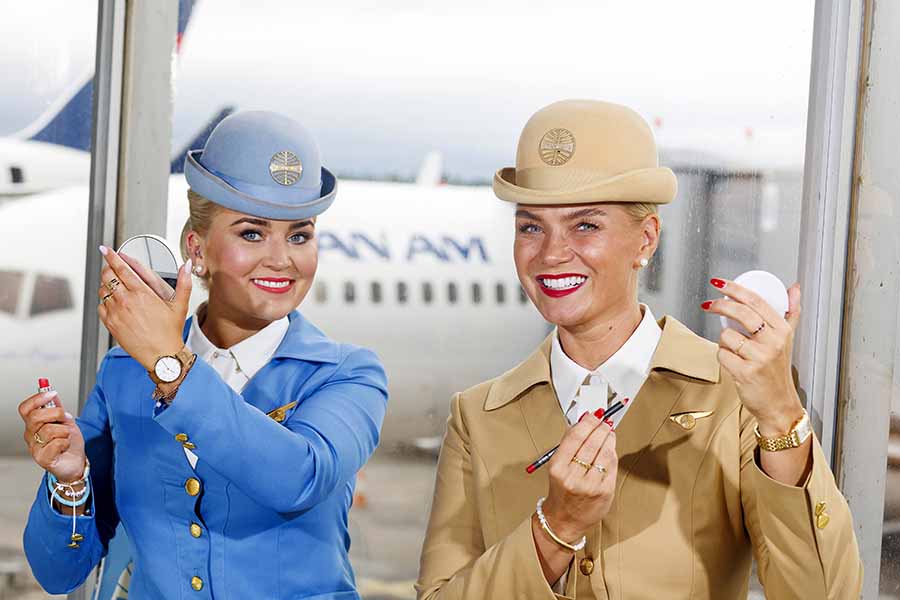
Pan Am in Ireland
Pan America’s substantial presence in Ireland is fondly remembered by a generation of travel trade professionals. It was headed up by sales manager Con McGovern, a charismatic Drumlish man, who had played county with Longford and Galway. On the playing field he was one of a small group who won three Leinster senior colleges in a row (with Father Carney’s legendary Saint Mels team in the 1930s) and then won three Sigersons in a row (with UCG in 1938-40), was a sub on the defeated Galway 1940 All Ireland final team, and after he retired, carried his passion to golf. The Con McGovern cup is still played for the Mens Open Singles Strokes competition in Dun Laoghaire golf club.
Mr McGovern first encountered aviation as one of a select and highly trained group of army officers from the G2 Intelligence Unit who were based at Foynes to ensure that our neutrality was maintained as the Vought Sikorsky 44A Flying boats (, the only three ever built) operated by American Export Airlines stopped over during WW2.
He was supported by Michael Brennan, Art Martin, Felix Cronin and Eileen Meehan. Michael was to move to Intercontinental Hotels, one of PanAm’s associate companies, in a managerial capacity. Felix later became Irish Manager for Air Canada.
In Shannon they had Harry Cripps and Robin Bogan who married Eva Hogan and Mary Hedderman of TWA in a double the cross-airline romance, and the eye-catching ground hostesses Masie Fitzgerald and Marie Culligan. They also had Charlie Burke, remembered for his solution for that peculiarly Irish 1950s problem, clergy looking for upgrades: “Yes, Reverend Sir, what is it I can do for you?”
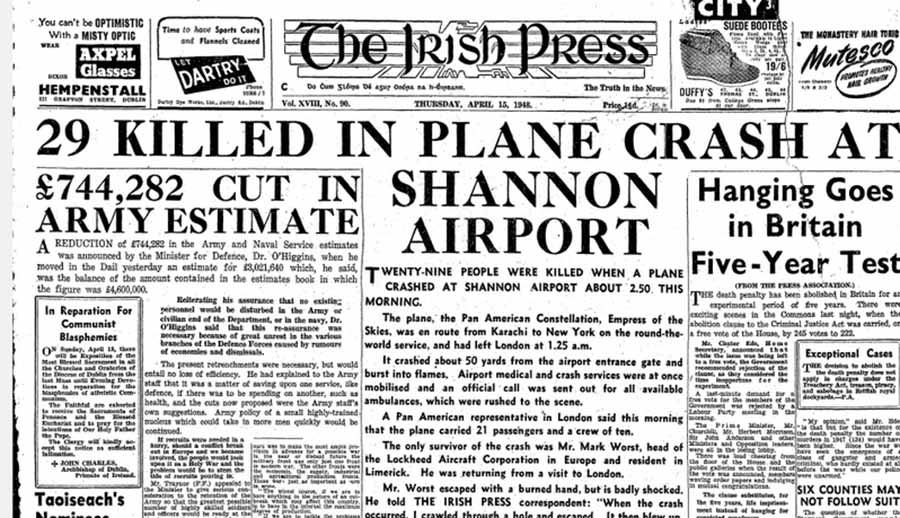
Two crashes in Ireland, one fatal
Tragically, Pan Am featured in two of of the 15 air tragedies relating to Irish airspace or airlines. Pan Am Flight 1-10, a Lockheed Constellation named Clipper Empress of the Skies (registration NC-88858), crashed on April 15, 1948, while attempting to land at Shannon Airport, Ireland, during a round-the-world flight from San Francisco to New York. The accident killed 30 of the 31 people on board, 10 crew members and 20 passengers, with one passenger surviving. The U.S. Civil Aeronautics Board (CAB) investigation determined that the probable cause was the crew’s continuation of an instrument approach to an altitude insufficient to clear terrain, with a possible contributing factor being the failure of the pilot’s instrument fluorescent light.
On June 22, 1959, Pan American World Airways Flight 216, a Douglas DC-6B registered as N5026K and named Clipper Panama, was destroyed without loss of life during takeoff from Shannon Airport, due to a catastrophic engine failure and subsequent fire. The aircraft, a cargo flight under charter, was en route from Frankfurt, Germany, to New York City, with intermediate stops at London Heathrow and Shannon. The flight carried six crew members, Captain Robert Realm, First Officer Henry R. Hayes, and four additional crew, and two passengers. After refueling at Shannon, the aircraft began its takeoff roll from Runway 24. As takeoff power was applied, a loud noise was heard, signaling the failure of the number four engine (right outboard), which separated from the wing. A fire erupted, engulfing the aircraft. The crew promptly abandoned the takeoff, and all eight people on board evacuated via the emergency chute within 30 seconds, escaping without serious injury. Tragically, six dogs in the cargo hold perished. The aircraft was consumed by fire and declared a total loss.
Demise of the Blue Globe
The 1970s and 1980s brought challenges. The 1978 Airline Deregulation Act in the United States intensified competition, and rising fuel costs strained Pan Am’s finances. The airline’s acquisition of National Airlines in 1980, aimed at bolstering domestic routes, proved costly and ill-fated. By the late 1980s, Pan Am was selling assets, including its London-Heathrow routes to United Airlines in 1985. The tragic bombing of Pan Am Flight 103 over Lockerbie in 1988 further damaged the airline’s reputation and financesCrippled by losses, Pan Am declared bankruptcy and ceased operations on 4 December 1991. That November, Delta Air Lines acquired Pan Am’s transatlantic routes, including services to Shannon and Dublin, marking the end of Pan Am’s operations in Ireland.
Despite its collapse, Pan Am’s legacy endures. Several revival attempts followed, including a short-lived effort in 2010 that failed due to legal issues with its CEO. In 2025, Pan Am is set to make a symbolic return through a luxury charter experience titled “Tracing the Transatlantic.” Organised by Criterion Travel and Bartelings, in collaboration with Pan Am Global Holdings and the Pan Am Museum Foundation, this 12-day journey from 27 June to 8 July 2025 recreates Pan Am’s historic transatlantic routes. Departing from New York’s JFK Airport, the itinerary includes stops in Bermuda, Lisbon, Marseille, London, and Foynes, Ireland, using a Boeing 757-200 with 50 business-class seats. Priced at £46,000 (double occupancy) or £50,300 (single), the trip offers upscale catering, branded swag, and stays at luxury hotels like the Waldorf Astoria and The Savoy. Led by CEO Craig Carter, this venture celebrates Pan Am’s golden age while testing the brand’s viability for future projects, including a potential commercial airline relaunch by 2027, Pan Am’s 100th anniversary
The recent Pan Am-branded flight, a $60,000-per-seat journey hosted by Criterion Travel and Bartelings, underscores the enduring allure of Pan Am’s legacy. Passengers, greeted by flight attendants in vintage uniforms, visited the Foynes Flying Boat Museum on 26 June 2025, celebrating the airline’s historic ties to Ireland.



